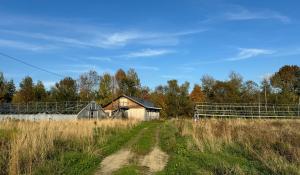
What is Regenerative Agriculture and why is it different from Organic?
Within the past century, agriculture has become one of the world’s largest drivers of climate change. The industrial processes, chemical inputs, and repeated, long-term tillage of working lands has been implicated not just for its impacts on the climate, but also for its destruction of biodiversity, soil health, depleted nutrition, and farm economic resiliency. Regenerative agriculture aims to remedy this.
Regenerative agriculture pertains to a variety of farming practices that focus on soil health and regeneration. Green America recognizes seven pillars of regenerative agriculture: minimize soil disturbance; living roots in the ground year-round; keeping year-round soil coverage; maximizing diversity above and below the ground; reducing synthetic inputs; continuous learning; appropriate integration of livestock. It begins with organic principles, like reducing the use of pesticides and fossil fuel-based fertilizers; and then goes beyond that to includes a number of other practices designed to optimize soil health, nutrition, and to bring carbon back into the earth. Those practices include:
- no-till
- cover-cropping
- composting
- diversifying crops
- integrative animal management.

Nutritional Difference between Conventionally Grown & Regeneratively Grown Crops
Whereas conventional crops have higher levels of heavy metals in them, organic and regenerative crops have higher levels of vitamins and minerals. Whereas, conventional crops contain greater pesticide levels, regenerative crops contain higher levels of phytochemicals, which are shown to exhibit health-protective antioxidant and anti-inflammatory properties. Tilling the soil, a practice of conventional and organic farming, disrupts the soil so much that the microbes and worms are disturbed. Disrupting these microbial and worm communities affects crop mineral uptake. Worms ingest microbes and play a vital role in decomposing organic matter, keeping the nutrient cycle going and enhancing soil nutrient availability.
Finally, regenerative crops have an overall higher nutrient density.

Why Nutrient Density Matters
Nutrient density is the ratio of nutrients per calorie, or the nutritional value to energy intake. The higher the nutrient density of a food is, the more quickly we feel full and don’t overeat. Higher nutrient density helps our brains recognize that we’ve had enough to eat. Higher nutrient density also protects us from many illnesses and chronic diseases by reducing inflammation in the body. Furthermore, you are lowering your exposure to harmful chemicals that disrupt your body’s proper functioning by eating pesticide-free food. Exposure to pesticides has been shown to change your cells down to your DNA, confusing your body so it doesn’t recognize when it’s full, teaching it to store fat. Regeneratively grown foods are shown to have high nutrient densities, including 34% more vitamin K, 11% more calcium, and 27% more copper.
| Element | CC/Conventional (%) |
| Boron | +41 |
| Sodium | -1 |
| Magnesium | +29 |
| Potassium | +26 |
| Manganese | +35 |
| Iron | +20 |
| Zinc | +56 |
Where to Find Regeneratively Grown Food
While it may be difficult to find and recognize regeneratively grown produce now, consumers have options.
Grow your own food
By planting a garden, you know exactly what’s going into it. It also saves you money at the grocery store and helps fight climate change by reducing the number of miles driven to ship and obtain the produce. Growing an abundant garden is easier and takes far less time than you might think.
Check out Green America’s Climate Victory Gardens to learn more!
Talk to the farmers at your local farmers’ market
Farmers’ markets are a great way to support local farms and buy the freshest produce. Don’t be shy about engaging sellers and asking about their farming practices! Who knows—you might even find a farm you really love that has a CSA you can join.
Join a local CSA
Community Supported Agriculture, or CSAs, is a setup where consumers connect directly with a farm and buy shares of the season's harvest. Typically, you buy into a CSA in the spring, purchasing crops upfront for weekly or bi-weekly pickups during the entire season.
Engage food companies
Write, tweet, or call the companies and grocery stores that provide your favorite products and ask them to source from regenerative farms. Encourage them to help the farmers they work with transition to regenerative practices. Let them know you care about how your food is grown and sourced.
Look for Soil & Climate Health Initiative Verified Label
Green America's new label Soil & Climate Health Initiative Verified is groundbreaking and shows customers which companies care about regenerative agriculture.

Products carrying this label are made with ingredients from farms with confirmed commitments and actions to implement regenerative agriculture. In order to earn verification, farms track soil health outcomes, use practices that protect and nourish the soil, and commit to continuous improvement.
Green America and our Soil & Climate Initiative supports farms capturing carbon in soils—helping the climate crisis—building biodiversity above and below ground, reducing the use of synthetic fertilizers, pesticides, and herbicides, and improving water retention in soils.






